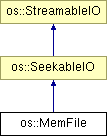
Inheritance diagram for os::MemFile:

Public Member Functions | |
| MemFile () | |
| Default constructor. | |
| MemFile (const void *pData, uint32 nLen) | |
| Constructor. | |
| ~MemFile () | |
| virtual ssize_t | Read (void *pBuffer, ssize_t nSize) |
| virtual ssize_t | Write (const void *pBuffer, ssize_t nSize) |
| virtual ssize_t | ReadPos (off_t nPos, void *pBuffer, ssize_t nSize) |
| virtual ssize_t | WritePos (off_t nPos, const void *pBuffer, ssize_t nSize) |
| virtual off_t | Seek (off_t nPos, int nMode) |
| virtual void | SetSize (uint32 nSize) |
| Set the size of the internal buffer. | |
Classes | |
| class | Private |
| MemFile::MemFile | ( | ) |
| MemFile::MemFile | ( | const void * | pData, | |
| uint32 | nLen | |||
| ) |
| pData | Pointer to the data you want to access as a stream. | |
| nLen | Length of the data. |
const char bitmap[] = { // Bitmap data }; MemFile cBitmapStream( bitmap, sizeof( bitmap ) ); // Now cBitmapStream may be used like an ordinary stream object: Image *cImg = new BitmapImage( &cBitmapStream );
| MemFile::~MemFile | ( | ) |
| ssize_t MemFile::Read | ( | void * | pBuffer, | |
| ssize_t | nSize | |||
| ) | [virtual] |
Implements os::StreamableIO.
| ssize_t MemFile::Write | ( | const void * | pBuffer, | |
| ssize_t | nSize | |||
| ) | [virtual] |
Implements os::StreamableIO.
| ssize_t MemFile::ReadPos | ( | off_t | nPos, | |
| void * | pBuffer, | |||
| ssize_t | nSize | |||
| ) | [virtual] |
Implements os::SeekableIO.
| ssize_t MemFile::WritePos | ( | off_t | nPos, | |
| const void * | pBuffer, | |||
| ssize_t | nSize | |||
| ) | [virtual] |
Implements os::SeekableIO.
| off_t MemFile::Seek | ( | off_t | nPos, | |
| int | nMode | |||
| ) | [virtual] |
Implements os::SeekableIO.
| void MemFile::SetSize | ( | uint32 | nSize | ) | [virtual] |
| nSize | The new buffer size. |
 1.5.1
1.5.1